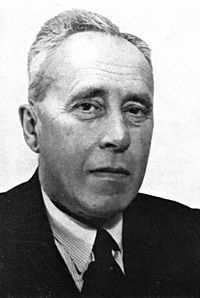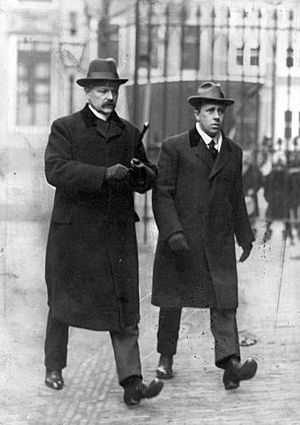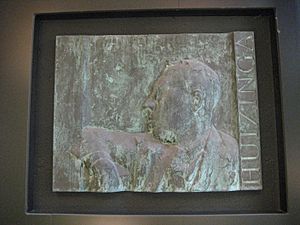Johan Huizinga facts for kids
Quick facts for kids
Johan Huizinga
|
|
|---|---|
 |
|
| Born | 7 December 1872 Groningen, Netherlands
|
| Died | 1 February 1945 (aged 72) De Steeg, Netherlands
|
| Occupation | Historian, professor, writer |
| Employer | Groningen University (1905–1923) Leiden University (1915–1942) |
|
Works
|
The Autumn of the Middle Ages, Homo Ludens |
Johan Huizinga (born 7 December 1872 – died 1 February 1945) was a Dutch historian. He is known as one of the people who helped create modern cultural history. This field looks at how people lived, thought, and created things in the past.
Life Story


Johan Huizinga was born in Groningen, a city in the Netherlands. His father, Dirk Huizinga, was a professor who studied how the body works (physiology). Johan's mother, Jacoba Tonkens, passed away when he was only two years old.
He began his studies by learning about Indo-European languages. These are a large family of languages spoken across Europe and parts of Asia. He earned his first degree in 1895. After that, he studied comparative linguistics, which means comparing different languages. He became very good at Sanskrit, an ancient language from India. In 1897, he wrote his special research paper (called a doctoral thesis) about the role of jesters in plays from India.
Around 1902, Johan became very interested in the Middle Ages and the Renaissance. These were important periods in European history. He kept teaching about Eastern cultures (as an Orientalist) until 1905. Then, he became a professor of history at Groningen University. In 1915, he moved to Leiden University to teach history there. He worked at Leiden until 1942. In 1916, he became a member of the important Royal Netherlands Academy of Arts and Sciences.
In 1942, the Germans had taken over the Netherlands. Huizinga spoke out against them. His words matched what he had written in the 1930s about Fascism, a strict political system. Because of his views, the Nazis held him for a few months in 1942. When they let him go, he was not allowed to return to Leiden. He then lived with a friend in De Steeg, near Arnhem. He passed away there just a few weeks before the Nazis were defeated. He is buried in a church graveyard in Oegstgeest.
His Important Works
Huizinga looked at history in a unique way. He believed that art and public events were very important in understanding the past. His most famous book is The Autumn of the Middle Ages, published in 1919. This book explores the end of the Middle Ages in Europe.
Other important books he wrote include Erasmus (1924) and Homo Ludens (1938). In Homo Ludens, he explored the idea that playing games is a very basic and important part of human culture. He also wrote books about American history and Dutch history from the 1600s.
Huizinga was worried about the rise of Nazism in Germany. He wrote several books where he shared his ideas about culture. He thought that modern society was becoming too focused on machines and organization. He felt this was replacing the natural, creative ways that cultures used to grow.
Huizinga Lecture
The Huizinga Lecture is a special event held every year in the Netherlands. It is a famous lecture about cultural history or philosophy. This lecture is given in honor of Johan Huizinga and his important ideas.
Family
Johan Huizinga's son, Leonhard Huizinga, also became a well-known writer in the Netherlands. Leonhard was especially famous for his funny books about two Dutch noble twins, Adrian and Oliver.
Images for kids
-
Huizinga plaque at Leiden University
See also
 In Spanish: Johan Huizinga para niños
In Spanish: Johan Huizinga para niños


